Intermediate Algebra
Answer/Discussion to Practice Problems
Tutorial 18: Practice Test on Tutorials 12 - 17
Problems 1a - 1b: Name the quadrant or axis in which the point
lies. |
1a. (2, - 4)
 Answer: Answer:
(2, -4) lies in Quadrant IV. |
1b. (0, 4)
 Answer: Answer:
(0, 4) lies on the y-axis. |
Problems 2a - 2b: Determine whether the equation is
linear or not. Then graph the equation by plotting points. |
2a. 
 Answer: Answer:
|
If we subtract 3x from both sides, then
we can write the given equation as -3x + y = - 4.
Since we can write it in the standard form Ax + By = C, then we have a linear equation.
This means that we will have a line when we go to graph this. |
Step 1: Find three ordered pair solutions.
Solutions:
|
x
|

|
(x, y)
|
|
-1
|
y = 3(-1) - 4 = -7
|
(-1, -7)
|
|
0
|
y = 3(0) - 4 = - 4
|
(0, - 4)
|
|
1
|
y = 3(1) - 4 = -1
|
(1, -1)
|
|
Step 2: Plot the points found in step 1.
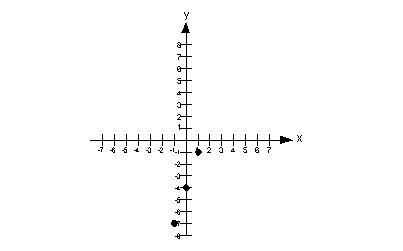
|
Step 3: Draw the graph.
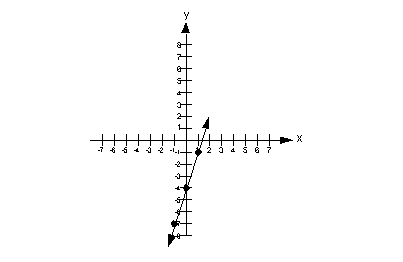
|
2b. 
 Answer: Answer:
|
If we subtract the x squared from both
sides, we would end up with -x squared + y = -7. Is this a
linear equation? Note how we have an x squared
as opposed to x to the one power.
It looks like we cannot write it in the form Ax + By = C because the x has to be to the one power, not squared. So this is not a linear
equation. |
Step 1: Find six or seven ordered pair solutions.
Solutions:
|
x
|

|
(x, y)
|
|
-3
|
y = (-3)^2 - 7 = 2
|
(-3, 2)
|
|
-2
|
y = (-2)^2 - 7 = -3
|
(-2, -3)
|
|
-1
|
y = (-1)^2 - 7 = -6
|
(-1, -6)
|
|
0
|
y = (0)^2 - 7 = -7
|
(0, -7)
|
|
1
|
y = (1)^2 - 7 = -6
|
(1, -6)
|
|
2
|
y = (2)^2 - 7 = -3
|
(2, -3)
|
|
3
|
y = (3)^2 - 7 = 2
|
(3, 2)
|
|
Step 2: Plot the points found in step 1.
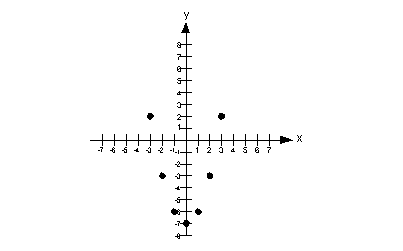
|
Step 3: Draw the graph.
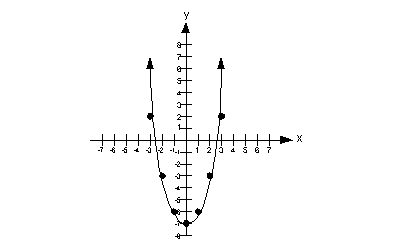
|
Problem 3a: Find the domain and range of the relation.
Also, determine whether the relation is a function. |
3a. {(-1, 3), (-1, 4), (-2, 5), (-3, 6)}  Answer: Answer:
|
Domain
We need to find the set of all input values. In terms of ordered
pairs, that correlates with the first component of each one. So,
what do you get for the domain?
If you got {-1, -2, -3}, you are correct!
Range
We need to find the set of all output values. In terms of ordered
pairs, that correlates with the second component of each one. So,
what do you get for the range?
If you got {3, 4, 5, 6}, you are absolutely right!
Is this a function or not?
We need to ask ourselves, does every first element
(or input) correspond with EXACTLY ONE second element (or output)?
In this case, the answer is no. -1 associates with two values, 3
and 4.
So, this relation would not be an example of
a function. |
Problems 4a - 4b: Find the domain and range of each relation.
Use the vertical line test to determine whether each graph is a graph of
a function. |
4a.
 Answer: Answer:
|
Domain
We need to find the set of all input values. In terms
of ordered pairs, that correlates with the first component of each one.
In terms of this two dimensional graph, that corresponds with the x values
(horizontal axis).
Since that is the case, we need to look to the left and right and see if there are any end points. In this case, note how the line
has arrows at both ends, that means it would go on and on forever to
the right and to the left.
This means that the domain is {x | x is a real number}.
Range
We need to find the set of all output values. In terms
of ordered pairs, that correlates with the second component of each one.
In terms of this two dimensional graph, that corresponds with the y values
(vertical axis).
Since that is the case, we need to look up and down and see if
there are any end points. In this case, note how the line has arrows
at both ends, that means it would go on and on forever up and down.
This means that the range is {y | y is a real number}.
Vertical Line Test
This graph would pass the vertical line test, because there would not
be any place on it that we could draw a vertical line and it would intersect
it in more than one place.
Therefore, this is a graph of a function. |
4b.
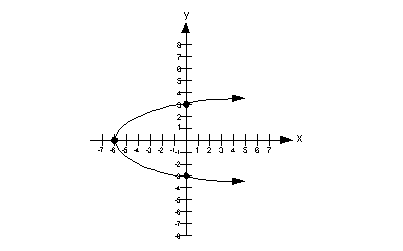
 Answer: Answer:
|
Domain
We need to find the set of all input values. In terms
of ordered pairs, that correlates with the first component of each one.
In terms of this two dimensional graph, that corresponds with the x values
(horizontal axis).
Since that is the case, we need to look to the left and right and see if there are any end points. In this case, note that the
farthest left point is (-6, 0) and it keeps going and going to the right.
That means that if we wrote out ordered pairs for all the values, we would
use the values greater than or equal to -6 for x.
This means that the domain is {x | x>
-6}.
Range
We need to find the set of all output values. In terms
of ordered pairs, that correlates with the second component of each one.
In terms of this two dimensional graph, that corresponds with the y values
(vertical axis).
Since that is the case, we need to look up and down and see if
there are any end points. In this case, note how the curve
has arrows at both ends, that means it would go on and on forever up and
down.
This means that the range is {y | y is a real number}.
Vertical Line Test
This graph would not pass the vertical line test, because there is
at least one place on it that we could draw a vertical line and intersect
it in more than one place. In fact, there a lot of vertical lines
that we can draw that would intersect it in more than one place, but we
only need to show one to say it is not a function.
The graph below shows one vertical line drawn through our graph that
intersects it in two places.
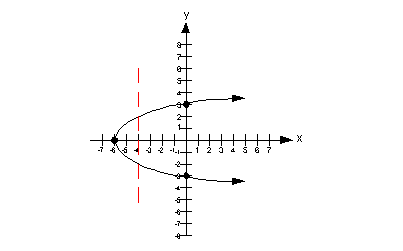
Therefore, this is not a graph of a function. |
Problem 5a: Decide whether y is a function
of x. |
5a. 
 Answer: Answer:
|
To check if y is a function of x,
we need to solve for y first and then check
to see if there is only one output for every input. |
|
*Inverse of add 2x is
sub. 2x
|
At this point we ask ourselves, would we get one value for y if you plug in any value for x?
If you answered yes, you are right on.
Note that since it is solved for y, y is
our output value and x is our input value.
Since our answer to that question is yes, that means by definition, y is a function of x. |
Problems 6a - 6b: Find the functional values. |
6a. 
; f(0), f(1), f(-1)
 Answer: Answer:
|
|
*Plug in 0 for x and evaluate
*Plug in 1 for x and evaluate
*Plug in -1 for x and evaluate
|
So our answers are f(0) = 1, f(-1)
= 3, and f(1) = 9 |
6b.  ;
g(0), g(½), g(5)
 Answer: Answer:
|
|
*This is a constant function that is always
-2
*This is a constant function that is always
-2
*This is a constant function that is always
-2 |
So our answers are g(0) = -2, g(1/2)
= -2, and g(-5) = -2. |
Problems 7a - 7b: Graph each linear function using the x-
and y- intercepts. |
7a. 
 Answer: Answer:
|
Step 1: Find the x- and y- intercepts.
Let's first find the x-intercept. |
|
*Find x-int. by
replacing y with 0
*Inverse of mult. by 2 is div. by 2
|
The x-intercept is (1/2, 0).
Next we will find the y-intercept. |
|
*Find y-int. by
replacing x with 0
*Inverse of mult. by -1 is div. by -1
|
The y-intercept is (0, -1) |
Step 2: Find at least one more point.
We can plug in any x value we want as long
as we get the right corresponding y value and
the function exists there.
Let's put in an easy number x =
1: |
|
*Replace x with
1
*Inverse of add 2 is sub. 2
*Inverse of mult. by -1 is div. by -1
|
So the ordered pair (1, 1) is another solution to our function.
Note that we could have plugged in any value for x: 5, 10, -25, ...,
but it is best to keep it as simple as possible.
Solutions:
|
x
|
y
|
(x, y)
|
|
1/2
|
0
|
(1/2, 0)
|
|
0
|
-1
|
(0, -1)
|
|
1
|
1
|
(1, 1)
|
|
Step 3: Plot the intercepts and point(s) found in
steps 1 and 2.
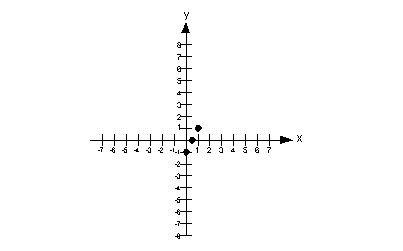
|
Step 4: Draw the graph.
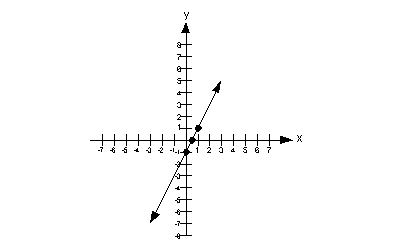
|
7b. 
 Answer: Answer:
|
Step 1: Find the x- and y- intercepts.
Let's first find the x-intercept. |
|
*Find x-int. by
replacing y with 0
*Inverse of mult. by 4 is div. by 4 |
The x-intercept is (0, 0).
Since the x-intercept came out to be (0,
0), then it stands to reason that when we put in 0 for x to find the y-intercept we will get (0,
0). |
Step 2: Find at least one more point.
Since we really have found only one point, this time we better find
two additional solutions so we have a total of three points.
We can plug in any x value we want as long
as we get the right corresponding y value and
the function exists there.
Let's put in an easy number x = 1: |
So the ordered pair (1, 4) is another solution to our function.
Let's put in another easy number x = -1: |
So the ordered pair (-1, -4) is another solution to our function.
Note that we could have plugged in any value for x: 5, 10, -25, ...,
but it is best to keep it as simple as possible.
Solutions:
|
x
|
y
|
(x, y)
|
|
0
|
0
|
(0, 0)
|
|
1
|
4
|
(1, 4)
|
|
-1
|
-4
|
(1, -4)
|
|
Step 3: Plot the intercepts and point(s) found in
steps 1 and 2.
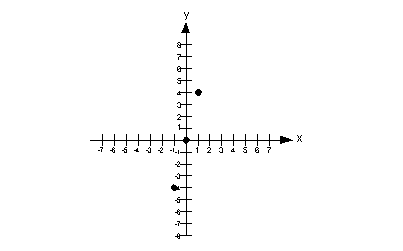
|
Step 4: Draw the graph.
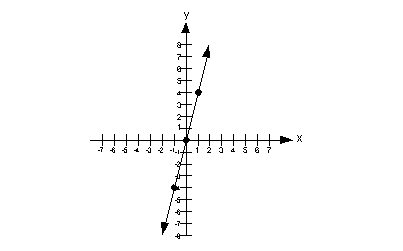
|
Problem 8a: Graph the linear equation. |
8a. 
 Answer: Answer:
|
If we subtract 4 from both sides, we would get y = - 4, which would fit the form y = c.
With that in mind, what kind of line are we going to end up with?
Horizontal. |
Step 1: Find the x- and y- intercepts
AND
Step 2: Find at least one more point
Since this is a special type of line, I thought I would talk about steps
1 and 2 together.
It doesn't matter what x is, y is always - 4. So for our solutions we just need three ordered pairs
such that y = - 4.
Note that the y-intercept (where x =
0) is at (0, - 4).
Do we have an x-intercept? The answer is no. Since y has to be - 4, then it can never equal 0, which is the criteria of an x-intercept.
Also, think about it, if we have a horizontal line that crosses the y-axis
at - 4, it will never ever cross the x-axis.
So some points that we can use are (0, - 4), (1, - 4) and (-1, -
4). These are all ordered pairs that fit the criteria of y having to be 4.
Of course, we could have used other solutions, there are an infinite
number of them.
Solutions:
|
x
|
y
|
(x, y)
|
|
0
|
- 4
|
(0, - 4)
|
|
1
|
- 4
|
(1, - 4)
|
|
-1
|
- 4
|
(-1, - 4)
|
|
Step 3: Plot the intercepts and point(s) found
in steps 1 and 2.
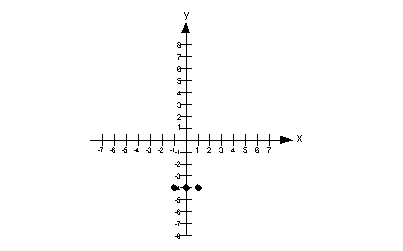
|
Step 4: Draw the graph.
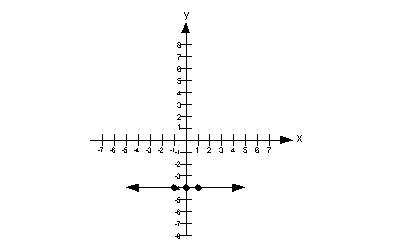
|
Problems 9a - 9b: Find the slope of the straight line that passes
through the given points. |
9a. (-7, 3) and (4, -1)  Answer: Answer:
|
|
*Plug in x and y values into slope formula
*Simplify
|
The slope of the line is -4/11. |
9b. (5, 0) and (5, 4)  Answer: Answer:
|
|
*Plug in x and y values into slope formula
*Simplify
|
The slope of the line is undefined. |
Problems 10a - 10b: Graph the linear equation using the slope/intercept
form. |
10a. 
 Answer: Answer:
|
Step 1: Write the linear equation in the slope/intercept
form, if necessary. |
|
*Inverse of add 2x is sub. 2x
*Inverse of mult. by -3 is div. by -3
*Slope/intercept form of the line
|
Step 2: Identify the slope and y-intercept
of the linear equation. |
Looking at this equation and lining it up with the slope/intercept
form, what do you get for the slope and y-intercept?
I got m = 2/3 and y-intercept
is -2. |
Step 3: Plot the y-intercept point on the graph. |
Step 4: Use the slope to find a second point on the
graph. |
The slope is 2/3.
Starting on the y-intercept (0, -2), we will rise up 2 and run right
3.
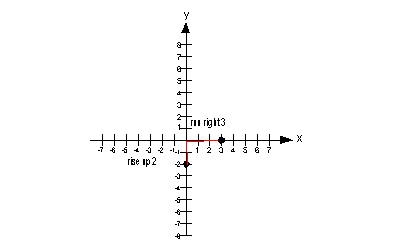
|
10b. 
 Answer: Answer:
|
Step 1: Write the linear equation in the slope/intercept
form if necessary.
This linear equation is already in the slope/intercept form. |
|
*Slope/intercept form of the line |
Step 2: Identify the slope and y-intercept
of the linear equation. |
Lining up everything, what so you get for the slope and the y-intercept??
Note how we are missing a constant being added to the x term. If we are missing that constant, what is it understood
to be???
The slope is -2 and the y-intercept is
0. |
Step 3: Plot the y-intercept point on the graph. |
Step 4: Use the slope to find a second point on the
graph. |
The slope is -2 or -2/1.
Starting on the y-intercept (0, 0), we will go down 2 and run right
1.
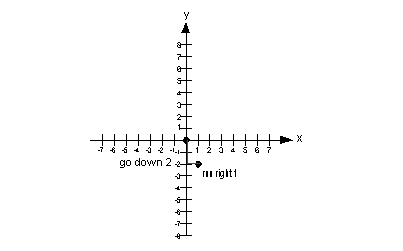
|
Problems 11a - 11c: Find the equation of the line with the
given conditions. Use function notation to write the equation. |
11a. Passes through the points (2, 3) and (-1, -3)  Answer: Answer:
|
What are the two things we need to write an equation of a line????
If you said any point on the line and the slope, you are correct.
Let's find that slope: |
|
*Slope formula
*Plug in values
*Simplify
|
OK, now we have our slope, which is 2.
We want to put the slope and one point into the point/slope equation. |
|
*Point/slope form of the line |
The directions said to write it using function notation. This
means we want to solve it for y (get it in
the slope/int form) and then put it the function notation. |
|
*Dist. 2 through ( )
*Inverse of sub. 3 is add 3
*Slope/intercept form of the line
*Function notation |
The line that passes through (2, 3) and (-1, -3)
in function notation is f(x) = 2x - 1. |
11b. Passes through the point (1, 1) and is parallel to
the line 
 Answer: Answer:
|
What are the two things we need to write an equation of a line????
If you said any point on the line and the slope, you are correct.
Find the slope of the parallel line: |
|
*Slope/intercept form of the line |
Now keep in mind that this is not the equation of our line but of the
line parallel to our line. We needed to write it this way so we could
get the slope. And it looks like the slope is 1/2. And since
our line is parallel to a line that has a slope of 1/2, our line also has
a slope of 1/2.
OK, now we have our slope, which is 1/2.
We want to put the slope and one point into the point/slope equation. |
|
*Point/slope form of the line |
The directions said to write it using function notation. This
means we want to solve it for y (get it in
the slope/int form) and then put it the function notation. |
|
*Dist. -3 through ( )
*Inverse of sub. 1 is add 1
*Slope/intercept form of the line
*Function notation |
The line that passes through (1, 1) and is parallel to y = 1/2 x - 4 is f(x) = 1/2 x +
1/2 |
11c. Passes through the point (-2, 3) and is perpendicular to
the line 
 Answer: Answer:
|
What are the two things we need to write an equation of a line????
If you said any point on the line and the slope, you are correct.
Find the slope of the perpendicular line: |
|
*Inverse of add x is sub. x
*Inverse of mult. by 3 is div. by 3
*Slope/intercept form of the line
|
In this form, we can tell that the slope of this line is -1/3.
Since our line is perpendicular to this we need to take the negative reciprocal
of -1/3 to get our slope.
What did you come up with?
I came up with 3 for the slope of our line.
Now we can go on to the equation of our line: |
|
*Point/slope form of the line |
The directions said to write it using function notation. This
means we want to solve it for y (get it in
the slope/int form) and then put it the function notation. |
|
*Dist. 3 through the ( )
*Inverse of sub. 3 is add 3
*Slope/intercept form of the line
*Function notation |
The line that passes through (-2, 3) and
is perpendicular to x + 3y = 5 is f(x) = 3x + 9. |
Problem 12a: Write the equation of the line. |
12a. Vertical and passes through (-3, 2).  Answer: Answer:
|
A vertical line is of the form x = c. So,
we will not use the point/slope form, but go right into setting up the
equation x = c.
Since it passes through (-3, 2), and a vertical line is in the form x = c,
where the x value is ALWAYS equal to the same
value throughout, this means our equation would have to be x =
-3.
Note that -3 is the x value of the ordered
pair given. |
Problem 13a: Graph the inequality. |
13a. 
 Answer: Answer:
|
Step 1: Graph the boundary line. |
I'm going to use the intercepts to help me graph the boundary line.
Again, you can use any method that you want, unless the directions say
otherwise.
When I'm working with only the boundary line,
I will put an equal sign between the two sides to emphasize that we are
working on the boundary line. That doesn't mean that I
changed the problem. When we put it all together in the end, I will put
the inequality back in.
x-intercept: |
|
*Replace y with
0
*Inverse of mult. by 2 is div. by 2
*x-intercept |
x-intercept is (3, 0)
y-intercept |
|
*Replace x with
0
*Inverse of mult. by -2 is div. by -2
*y-intercept |
y-intercept is (0, -3).
Plug in 1 for x to get a third solution: |
|
*Replace x with 1
*Inverse of add 2 is sub. 2
*Inverse of mult. by -2 is div. by -2
|
(1, -2) is another solution on the boundary line.
Solutions:
|
x
|
y
|
(x, y)
|
|
3
|
0
|
(3, 0)
|
|
0
|
-3
|
(0, -3)
|
|
1
|
-2
|
(1, -2)
|
Since the original problem has a <, this means it DOES NOT include
the boundary line.
So are we going to draw a solid or a dashed line for this problem?
It looks like it will have to be a dashed line.
Putting it all together, we get the following boundary
line for this problem:
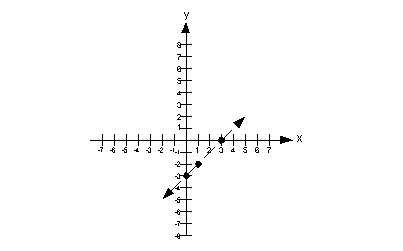
|
Step 2: Plug in a test point that is not on
the boundary line. |
Note how the boundary line separates it into two parts.
An easy test point would be (0, 0). Note that it is a point
that is not on the boundary line. In fact, it is located above the boundary
line.
Let's put (0, 0) into the original problem and see what happens: |
|
*Replacing x and y with 0
*True statement
|
Step 3: Shade in the answer to the inequality. |
Since our test point (0, 0) made our inequality TRUE, this means
it is a solution.
Our solution would lie above the boundary line. This means
we will shade in the part that is above it.
Note that the gray lines indicate where you would shade your
final answer.
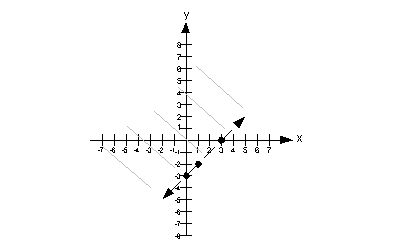 |
Problems 14a - 14b: Graph the inequalities. |
Graph the First Inequality 
Step 1: Graph the boundary line. |
If we wrote this as an equation, it would be y = 4. This is in
the form y = c,
which is one of our "special" lines.
Do you remember what type of line y = c graphs as?
It comes out to be a horizontal line.
Every y's value on the boundary line would
have to be 4.
Solutions:
|
x
|
y
|
(x, y)
|
|
0
|
4
|
(0, 4)
|
|
1
|
4
|
(1, 4)
|
|
2
|
4
|
(2, 4)
|
|
Since the original problem has a <, this means it DOES include
the boundary line.
So are we going to draw a solid or a dashed line for this problem?
It looks like it will have to be a solid line.
Putting it all together, we get the following boundary
line for this problem:
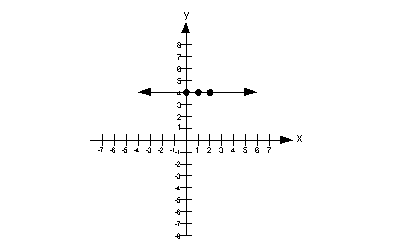
|
Step 2: Plug in a test point that is not on
the boundary line. |
Note how the boundary line separates it into two parts.
An easy test point would be (0, 0). Note that it is a point
that is not on the boundary line. In fact, it is located below the boundary
line.
Let's put (0, 0) into the original problem and see what happens: |
|
*Replace y with
0
*True statement |
Step 3: Shade in the answer to the inequality. |
Since our test point (0, 0) made our inequality TRUE, this means
it is a solution.
Our solution would lie below the boundary line. This means
we will shade in the part that is below it.
Note that the gray lines indicate where you would shade your
final answer.
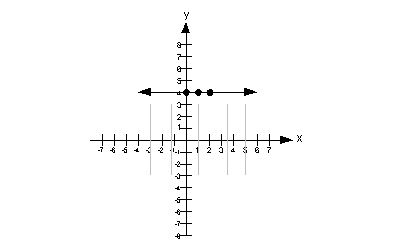 |
Graph the Second Inequality 
Step 1: Graph the boundary line. |
If we wrote this as an equation, it would be x = 1. This is in the form x = c,
which is one of our "special" lines.
Do you remember what type of line x = c graphs as?
It comes out to be a vertical line.
Every x's value on the boundary line would
have to be 1.
Solutions:
|
x
|
y
|
(x, y)
|
|
1
|
0
|
(1, 0)
|
|
1
|
1
|
(1, 1)
|
|
1
|
2
|
(1, 2)
|
|
Since the original problem has a >, this means it DOES NOT include
the boundary line.
So are we going to draw a solid or a dashed line for this problem?
It looks like it will have to be a dashed line.
Putting it all together, we get the following boundary
line for this problem:
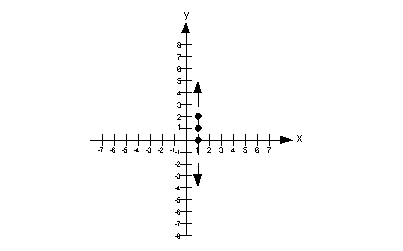
|
Step 2: Plug in a test point that is not on
the boundary line. |
Note how the boundary line separates it into two parts.
An easy test point would be (0, 0). Note that it is a point
that is not on the boundary line. In fact, it is located to the left of
the boundary line.
Let's put (0, 0) into the original problem and see what happens: |
|
*Replace x with
0
*False Statement
|
Step 3: Shade in the answer to the inequality. |
Since our test point (0, 0) made our inequality FALSE, this
means it is not a solution.
Our solution would lie to the right of the boundary line.
This means we will shade in the part that is to the right of it
Note that the gray lines indicate where you would shade your
final answer.
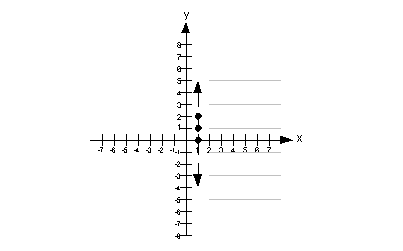 |
The union of the two inequalities is the area on the graph that was
shaded in either the first inequality OR the second one OR both.
This is what we get when we union these two inequalities:
Note that the gray lines indicate where you would shade your
final answer.
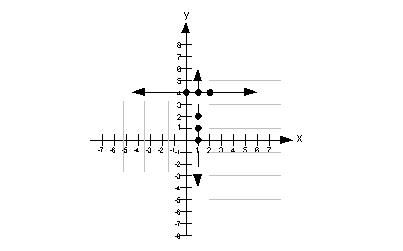
|
Graph the First Inequality 
Step 1: Graph the boundary line. |
If we wrote this as an equation, it would be x = -2. This is in the form x = c,
which is one of our "special" lines.
Do you remember what type of line x = c graphs as?
It comes out to be a vertical line.
Every x's value on the boundary line would
have to be -2.
Solutions:
|
x
|
y
|
(x, y)
|
|
-2
|
0
|
(-2, 0)
|
|
-2
|
1
|
(-2, 1)
|
|
-2
|
2
|
(-2, 2)
|
|
Since the original problem has a <, this means it DOES NOT include
the boundary line.
So are we going to draw a solid or a dashed line for this problem?
It looks like it will have to be a dashed line.
Putting it all together, we get the following boundary
line for this problem:
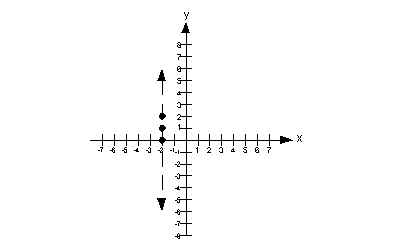
|
Step 2: Plug in a test point that is not on
the boundary line. |
Note how the boundary line separates it into two parts.
An easy test point would be (0, 0). Note that it is a point
that is not on the boundary line. In fact, it is located to the right of
the boundary line.
Let's put (0, 0) into the original problem and see what happens: |
|
*Replace x with
0
*False Statement
|
Step 3: Shade in the answer to the inequality. |
Since our test point (0, 0) made our inequality FALSE, this
means it is NOT a solution.
Our solution would lie to the left of the boundary line.
This means we will shade in the part that is to the left of it
Note that the gray lines indicate where you would shade your
final answer.
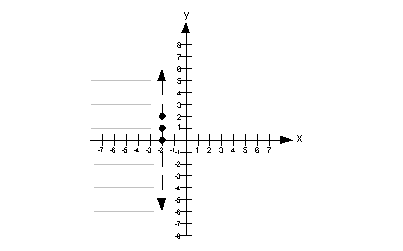 |
Graph the Second Inequality 
Step 1: Graph the boundary line. |
If we wrote this as an equation, it would be y = -2. This is
in the form y = c,
which is one of our "special" lines.
Do you remember what type of line y = c graphs as?
It comes out to be a horizontal line.
Every y's value on the boundary line would
have to be -2.
Solutions:
|
x
|
y
|
(x, y)
|
|
0
|
-2
|
(0, -2)
|
|
1
|
-2
|
(1, -2)
|
|
2
|
-2
|
(2, -2)
|
|
Since the original problem has a >, this means it DOES include
the boundary line.
So are we going to draw a solid or a dashed line for this problem?
It looks like it will have to be a solid line.
Putting it all together, we get the following boundary
line for this problem:
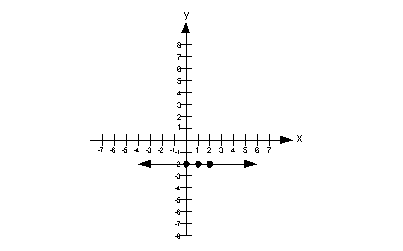
|
Step 2: Plug in a test point that is not on
the boundary line. |
Note how the boundary line separates it into two parts.
An easy test point would be (0, 0). Note that it is a point
that is not on the boundary line. In fact, it is located above the boundary
line.
Let's put (0, 0) into the original problem and see what happens: |
|
*Replace y with
0
*True statement
|
Step 3: Shade in the answer to the inequality. |
Since our test point (0, 0) made our inequality TRUE, this means
it is a solution.
Our solution would lie above the boundary line. This means
we will shade in the part that is above it
Note that the gray lines indicate where you would shade your
final answer.
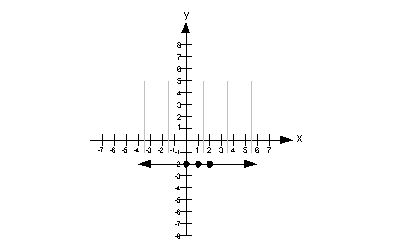 |
The intersection of the two inequalities is the area on the graph that
was shaded in BOTH the first inequality AND the second inequality.
It is the region where they overlap
This is what we get when we intersect these two inequalities:
Note that the gray lines indicate where you would shade your
final answer.
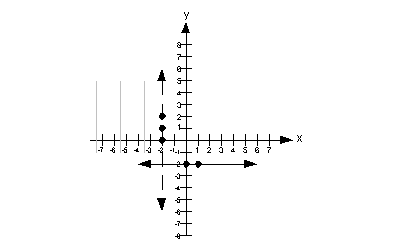
|

Last revised on July 6, 2011 by Kim Seward.
All contents copyright (C) 2001 - 2011, WTAMU and Kim Seward.
All rights reserved.
|
|


